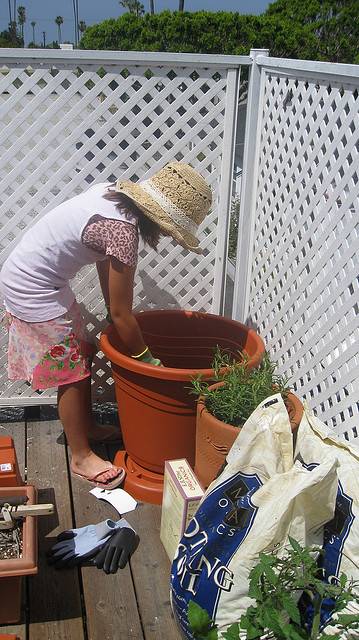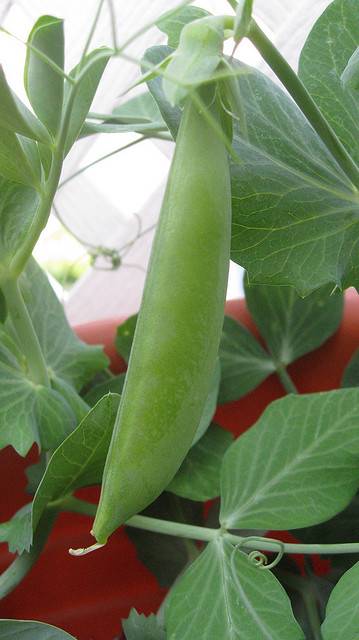Photos provided by Danette “Dizzle” Rivera.
This is the first of a four part series about claiming a better connection to our food. It’s also an exploration on how fresh food has a powerful impact on our overall health and community in more ways than we think.
In the gardening world, I probably have what’s technically called an asphalt thumb. I grew up a city kid with the belief that all the best foods came from 7-11. I had one relative who had an apricot tree in her backyard. The fruit was always mealy and covered with ants, which was gross so I never liked apricots and I couldn’t understand why this relative couldn’t just get me some good food from 7-11.
I had no real connection that food came from the ground until I was an adult. I mean, of course I vaguely understood this. A city kid sees photos in text books of huge industrial farms that might as well be on another planet, but the idea of running my hands through soil and coaxing something edible from a seed was all very, very foreign. It still seems like stuff of magic, but now I realize that an enlightened and fully realized version of health has to involve awareness of from where food comes. If whole, fresh nutrition is as important if not more important than any other aspect of health, then truly understanding its sources seemed an obvious path for me to explore, though, admittedly, I had no idea where to start.
A few years ago, I took my girls apple picking only because it sounded down-homey. I thought the trees would be plush and kelly green with perfect, glossy spheres ready to plop in my hand. Too many kids’ books are to blame for this image. And though the real trees looked a little rag tag and the apples were small and spectacled, our hair blew back when we bit into the fruit just seconds after twisting it off a branch. It was so sweet and crisp. We ate about a half a dozen apples before we got back to the car.
And I wondered if I’d be able to grow anything in my apartment or on the patio. If apples tasted that amazing immediately after picking them then I could only imagine the pop and fresh deliciousness of homegrown vegetables.
 After discovering many sources on flickr for apartment gardening, container gardening, and small yard gardening, I realized of course it could done and done well at that, and a couple summers ago, I gave patio gardening a shot. I dubbed us patio farmers. I was so happy to get my daughter’s hands in the dirt, too, because I didn’t want her to inherit the dreaded asphalt thumb. Surprisingly, we grew a beautiful little garden and if I could do this, then anybody can.
After discovering many sources on flickr for apartment gardening, container gardening, and small yard gardening, I realized of course it could done and done well at that, and a couple summers ago, I gave patio gardening a shot. I dubbed us patio farmers. I was so happy to get my daughter’s hands in the dirt, too, because I didn’t want her to inherit the dreaded asphalt thumb. Surprisingly, we grew a beautiful little garden and if I could do this, then anybody can.
Getting started is not hard. It takes some investment of time and materials. I did a lot of online research to get started, which is easy with all the information available to start a vegetable garden, but here are the very basic things I learned.
- Food will grow easily in containers. If it can grow in a backyard garden, it can grow in a container on a patio. Just check to see how much soil a particular plant will need.
- Anything can be used as a container. You can reuse anything big enough as long as it has holes for draining. Even shopping bags make good containers.
- Sun. Duh, right? But make sure where you park your plants gets a good amount of full sun. If you live in a very hot climate, certain plants may need some shade after many, continuous hours of sun.
- Water. I know, but I can’t tell you how long it took me to realize too much water can kill a crop faster than too little. I once asked a master gardener if I needed a special gadget that measured the moisture of soil when stuck in the ground. She said, “Yes” and then held up her index finger. “This is the gadget. Stick your finger in the soil and if it’s dry, water. If it’s damp, don’t.” Ah, gotta love a master slapping around a newbie.
- Soil. Good soil makes a difference and one great benefit of planting a container garden is a lot of bad soil issues that tend to mess up conventional vegetable gardens won’t be a problem because you control the soil from the beginning. I bought bags of organic soil from the nursery and asked for help on which was their best brand for vegetables. I learned that once a season is over, container soil is usually not reusable unless it has gone through composting.
- Food. Plants want food. And that can come in the form of fertilizer and the many different ways it can be administered, or you can use compost. I discovered the art of composting around the same time as when I wanted to plant the garden, so I didn’t have enough time to cultivate my own compost for the first planting. But I did invest in a rolling drum composter, which also sits on the patio, and I can’t praise this thing enough. It has cut down on a tremendous amount of kitchen waste and eventually it yielded dark, rich compost for the garden.
- Start with what’s easiest. A wide variety of herbs are easy: rosemary, basil, oregano, and mint. These can grow on a windowsill or the patio, and once you taste fresh herbs in your meals, it’s hard to go back. Tomatoes are easy as are zucchini, cucumbers, bell peppers, peas, and beans. I planted seeds and transplanted baby plants and both worked well, though transplanting was a little bit easier.
 I’m not going to claim I know how to grow the best apartment garden because I’m still learning. There are so many basic gardening resources online that tell you all you need to know to get started (like this one or this one). What I can tell you with authority is that raising food, even if it is a tiny bit, is an astounding experience. It is empowering.
I’m not going to claim I know how to grow the best apartment garden because I’m still learning. There are so many basic gardening resources online that tell you all you need to know to get started (like this one or this one). What I can tell you with authority is that raising food, even if it is a tiny bit, is an astounding experience. It is empowering.
When the first signs of food started budding from a plant, I felt as if we had created a miracle. When the sugar snap peas were ripe and ready on vine, my daughter and I ate them on the spot in complete amazement. They were so good. Quite obviously growing food has gone on forever. But that was the gap of disconnection I was trying to close. I think we did so pretty successfully, but it only opened the door for me. It made me want to find out more about growing food.
What are you growing this spring and summer?
Read the rest of the Down in the Dirt Series:
Part 2 – Community Gardens, From Beginning to Present






